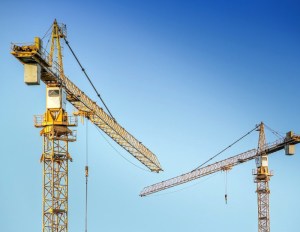Development Financing Slowdown Is Real
With investors and lenders becoming more cautious, developers are feeling the pinch.
If there’s a perception in the commercial property world right now that some lenders are hitting “Pause” on financing new deals and that construction financing is getting even harder to come by, that perception wouldn’t be implausible.
With the war in Europe, inflation, fears of recession, the Fed raising rates and other worries, there are nearly unprecedented levels of uncertainty about the economy right now.
Still, it’s debatable how suddenly construction financing and development equity may have become harder to get.
“New construction lending is just very hard to find,” says David Webb, CBRE vice chairman, Debt and Structured Finance.
Currently, to get any construction financing for deals over about $60 million to $70 million requires at least 50 percent equity, often with some recourse, he says.
Projects smaller than about $60 million may be feasible with local or regional lenders. “For these smaller deals, you can typically get better proceeds and better rates.”
Still, he explains, he hasn’t seen any sudden changes in financing conditions and says that the tightening has been a steady trend for more than six months.
Wally Reid, JLL senior managing director & co-leader of the firm’s national debt business line, remarks, “Construction financing has slowed down, but is still available for good deals and good borrowers.”
READ ALSO: Where to Find Opportunities as Economy Slows
He says that typical current terms might be non-recourse speculative industrial at 400 basis points over SOFR for shovel-ready, well-located deals seeking 60 percent LTV.
A search for clarity
“We’re at a point of transition for the commercial property market right now,” with high levels of uncertainty, observes Jamie Woodwell, head of Commercial Real Estate Research for the Mortgage Bankers Association.
People in the market are seeing faster changes, and the data is not necessarily current with deal-making, he says. “There’s definitely a challenge in working with the data right now,” because the situation is changing so quickly.
For example, banks’ holdings of construction loans have been increasing, from $436 billion at the end of October to $444 billion in late November.
Bearing in mind the time lag between deals and data, construction financing is up, but so is the cost, so deals are harder, Woodwell says.
Overall, while office development remains down from its pre-pandemic peak and retail has hit a record low during the pandemic, multifamily permitting and starts “continue to be very robust.” In fact, Woodwell says, the development of multifamily and industrial projects is “essentially at record levels,” with more multifamily under construction now than ever before.
That outlook isn’t necessarily the same from every angle, however. For example, in mid-December, Dodge Construction Network reported that total construction starts fell in November by 18 percent and that nonresidential building starts fell by 25 percent. Health care was one of the only nonresidential subsectors to increase on a month-to-month basis.
So, while tightening conditions for CRE development have perhaps not been sudden, they certainly seem to have been cumulative, even though the surge in construction costs has been moderating and even though rent growth in some product types has been strong.
Capital markets in 2023
If the capital markets are limiting development opportunities, what’s the outlook for them?
While Webb says, “I don’t think it will get much worse” for development financing, he also predicts, “You’re going to see a material cessation of development activity” as the limitations on obtaining construction financing bring development to a near-halt.
Already, he says, “Office is impossible. You can forget about office.”
As a practical matter, Webb says, “We believe the debt markets will improve, so we always need to test the market to see what positive changes have occurred.”
In a Capital Markets Special Report released in December by Marcus & Millichap Capital Corp. Steven Buchwald. senior managing director, IPA Capital Markets, noted that groundbreakings are slowing as construction financing becomes limited, ultimately because of investor underwriting and despite a deceleration of construction costs.
“Like the period after the great financial crisis,” he wrote, “there can often be no level at which a land buy pencils for LP investors who will conservatively underwrite higher exit cap rates to account for possible cap rate inflation.”
The lack of development resulting from tougher underwriting “may exacerbate supply/demand imbalances, and lead to even greater rent growth in some markets and product types,” according to the report.
READ ALSO: Uncertainty and Stress Carry Over into the New Year
CBRE’s David Webb agrees, predicting that a slump in development activity “will mean less supply, which means higher rents,” especially in multifamily properties, contributing to further inflation.
Right now, we need to get past the current round of Fed rate hikes and get some clarity about a possible recession, he says. It isn’t likely there won’t be one, Webb says, though he believes it will be shallow and mild.
Marcus & Millichap foresees a bifurcation between well-capitalized investors, who can take advantage of market dislocation, versus highly leveraged borrowers, who could face challenges.
“Expect higher leverage options to remain less available—particularly for construction loans, renovation loans, and other highly transitional business plans,” the report predicts. A key factor is that “constraints in debt service coverage ratios … are trumping debt yield and loan-to-value limits for the first time in recent history [emphasis added].”
Closer looks
CBRE’s recent U.S. Real Estate Market Outlook 2023 provides some insightful forecasts about specific product types as they face a drop in development/construction financing.
Jessica Morin, the company’s research director and head of office research, wrote that “High availabilities will keep developers and construction lenders on the sidelines in 2023.”
The less than 38 million square feet of office scheduled for delivery in 2023 is a 27 percent decrease from the five-year average. And though a reduced construction pipeline might lead to a significant shortage of prime office space in the longer term, in the meantime the completion of projects already underway and sizable quantities of space available for sublease will cause oversupply, “pressuring rents in 2023,” Morin concludes.
In the life science sector, according to Ian Anderson, CBRE’s senior director of research and analysis, both the economic slowdown and the pullback in private capital that have reduced demand for life science space are likely to persist in 2023.
“Many occupiers and investors are on the sidelines until there is greater clarity on the trajectory of interest rates and the economy,” he wrote.
Industrial contradictions
Industrial might be the most striking example of a product type that should be seeing more development activity—but evidently isn’t, or soon won’t—mostly because of factors outside the supply-and-demand metrics.
In a December report from Prologis, “Seven Supply Chain Predictions for 2023,” Prediction #1 is that warehouse development starts in this country will drop to a seven-year low, even though rent growth is above 10 percent.
Prologis supports this counterintuitive prediction in part because quarterly starts in Europe have already fallen by 30 percent from their peak, for the same reason the company expects a decline here: “a rapid rise in the cost of capital.” Prologis sees warehouse development starts in the U.S. falling by 60 percent, to less than 175 million square feet in 2023.
READ ALSO: Trends That Will Shape Industrial Real Estate in 2023
“A pullback of this magnitude,” Prologis warns, “would create a shortage of space in 2024,” leading to “another year of double-digit rent growth. Even if new demand fell to zero, the national vacancy rate would increase by just 260 bps to 5.9 percent, well below the long-term average.”
In the industrial chapter of the CBRE U.S. Real Estate Market Outlook 2023, James Breeze, CBRE senior director and global head of Industrial & Logistics Research, describes a similar dynamic: high levels of construction deliveries alongside “plummeting” construction starts.
He notes that a record 661 million square feet of industrial space was under construction as of the third quarter, “amid demand for high-quality facilities and a backlog of projects delayed by a shortage of construction materials.”
However, Breeze adds, the materials shortage seems to be resolving, and record completions in 2023 will likely increase overall U.S. industrial vacancy by 30 to 60 basis points. But he predicts groundbreakings to decline by more than 50 percent in early 2023 for much the same reasons Prologis cites: challenges with construction financing, plus economic uncertainty.
Breeze anticipates that fewer construction starts will result in completions falling to about 250 million square feet in 2024, “leading to a shortage of first-generation space and a return to record-low vacancy rates at a time when many companies will reenter the market.”










You must be logged in to post a comment.